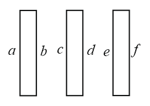Three parallel metallic plates, each area are kept as shown in the figure and charges , and are given to them. Edge effects are negligible. Calculate the charges on the two outermost surfaces and .


Important Questions on Electrostatics
A polythene piece rubbed with wool is found to have a negative charge of . Find the>
(a) number of electrons transferred.
(b) mass gained by the polythene.Two identical metal spheres and placed in contact are supported on insulating stand. What kinds of charge will and develop when a negatively charged ebonite rod is brought near ?
Two identical metal spheres carry charges of and respectively. When the spheres are separated by a large distance , the force between them is . Now the spheres are allowed to touch and then moved back to the same separation. Find the new force of repulsion between them.
Two neutral insulating small spheres are rubbed against each other and are then kept apart. If they attract each other with a force of , then
(i) calculate the charge on each sphere, and
(ii) calculate the number of electrons transferred from one sphere to the other during rubbing.
